JPEG’d Review: The Best Decentralized Lending Protocol For NFT Holders In 2024
JPEG’d is a decentralized lending protocol built on the Ethereum blockchain that allows non-fungible token (NFT) holders to open collateralized debt positions (CDPs) using their NFTs as collateral. In this JPEG’d review post, we’ll explore the features of JPEG’d, its tokenomics, and the roadmap for the platform’s future development.
Introduction
What is JPEG’d?
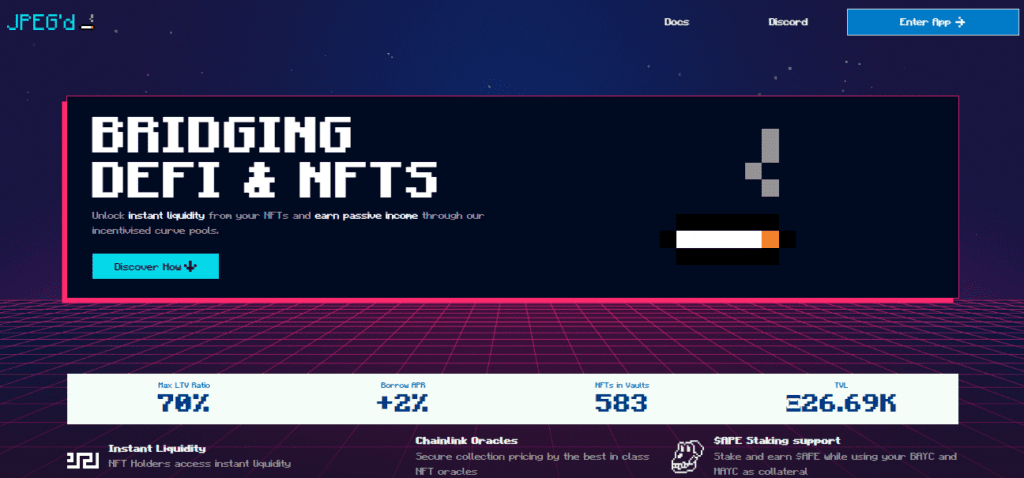
JPEG’d is a decentralized lending protocol built on the Ethereum blockchain. It allows non-fungible token (NFT) holders to open collateralized debt positions (CDPs) using their NFTs as collateral. This enables users to effectively obtain leverage on their NFTs by minting PUSd (the native stablecoin of the protocol) or pETH (the native Ethereum derivative of the protocol).
The protocol is governed by a token, $JPEG, which is responsible for overseeing, administering, and changing the parameters of the protocol. JPEG’d is completely permissionless, decentralized, and not controlled by any central entity. JPEG’s protocol aims to bridge the gap between DeFi and NFTs, allowing any NFT collection, voted by governance, to obtain a line of credit using their NFTs as collateral.
Supported Collections
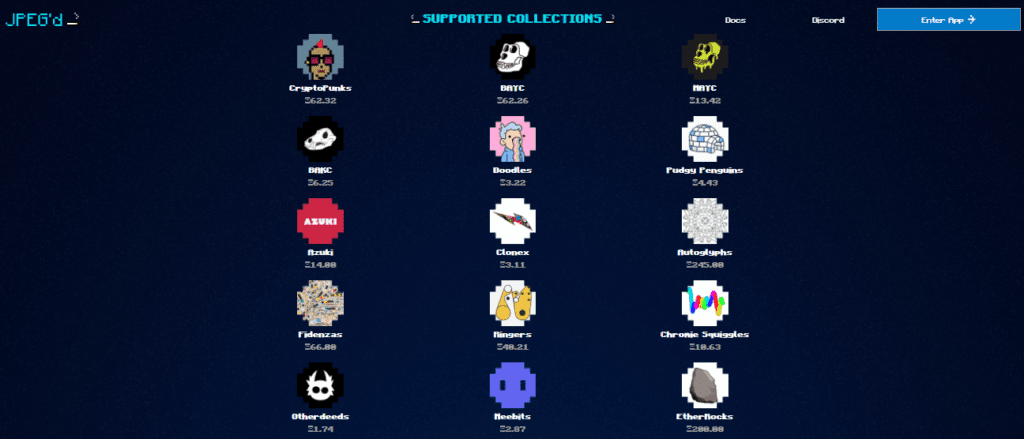
JPEG’d recently announced the currently supported collections on its platform, which include CryptoPunks, EtherRocks, Bored Ape Yacht Club, Mutant Ape Yacht Club, Doodles, Azuki, Pudgy Penguins, Clonex, Autoglyphs, Fidenza, Chromie Squiggles, Ringers, and Otherdeeds. In addition, JPEG’d has taken note of the rareness of certain items in NFT collections and is adding trait multipliers for CryptoPunks and Bored Apes to assess the value of specific rare items correctly.
More information on increasing credit limits for rare NFTs can be found under the Traits Boost Locking heading in the Locking Mechanism section of the documentation. For CryptoPunks, all NFTs are initially valued at floor, with the exception of Aliens and Apes, which are valued at a fixed 4,000 and 2,000 ETH, respectively. Governance can change these values in the future.
JPEG Cards
JPEG Cards are a series of 1,020 NFT cards that offer utility within the JPEG’d protocol. These cards can be staked for 1% of the JPEG supply over a month-long period. The JPEG cards display some of the most pervasive, captivating, and influential memes in crypto, and a subset of these cards will have additional utility on an upcoming platform.
Certain JPEG cards without a “cig” attribute will be whitelisted for culturally significant Weenis Warmers. Cigarette cards will be able to be locked and used to gain boosts on credit limit and liquidation ratio. Unstaking a cigarette card will lead to a loss of the boosts and may trigger liquidations of overborrowed positions. All JPEG cards will be whitelisted related to the upcoming AMM for NFTs that will be built. The total NFT supply is 1,000, plus an additional 20 honoraries, and about 50 cards are reserved for the team.
JPEG’d Protocol
Lending Mechanics
JPEG’d is a decentralized lending protocol that utilizes a peer-to-protocol lending mechanism, which means the protocol is independent of any liquidity provision or external factors. The lending mechanics offer several powerful options for borrowers, such as secured NFT floor pricing powered by Chainlink oracles, boosting position for larger borrowers, liquidation insurance, and more.
Users can borrow either PUSd or pETH against their supported NFT deposited in a JPEG’d vault. PUSd, the protocol’s native stablecoin, is minted against every borrow position at a 2% borrow rate and burned upon closing of the position. It can be conveniently swapped to any other main stablecoin (DAI, USDC, USDT) via the Curve PUSd/3CRV pool using the swap tab on the dApp.
Borrowing pETH, the protocol’s native Ethereum token can also be done at a 5% interest rate. However, a user cannot borrow PUSd and pETH on the same vault.
Vaults and Fees
JPEG’d uses a tiered vault structure (A, B, C, D) to charge interest on normalized demand and yield supply generated from yield farming. According to demand, new vaults can be opened for each collection, each with its own debt ceilings and tiers defined by PIPs. Interest is accrued at each block. The tiers charge fees as follows:
| Borrow Currency | Tier-A Annual Interest Rate | Tier-B Annual Interest Rate |
| pETH | 5% | 10% |
| PUSd | 2% | — |
Depending on availability, positions are automatically placed in the most suitable vault when borrowing from the vaults. If a borrowed amount exceeds the available pETH/PUSd, it will be migrated to the next vault with the available amount. It is possible to migrate a position to a lower-tiered vault using the migrate function on individual positions or whale mode.
Loan-to-Value Ratios
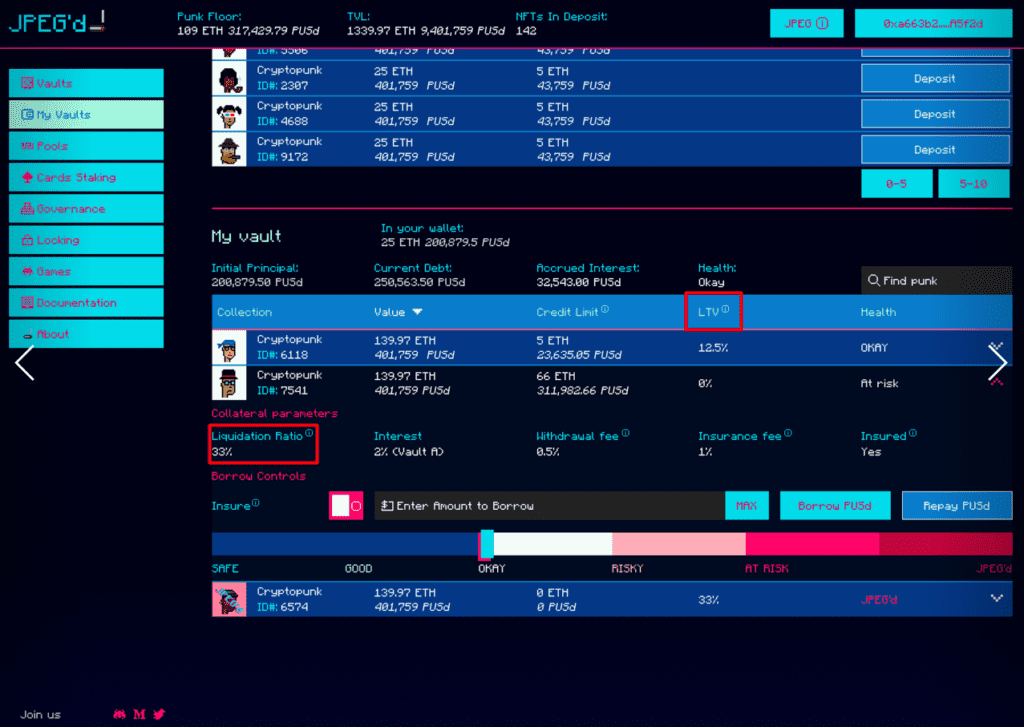
Debt positions in the lending protocol allow users to draw up to 35% of the collateral value by default. If the debt/collateral ratio exceeds 36%, liquidation will occur. For instance, if an NFT is worth 100 ETH, users can draw up to 35 ETH. If the NFT collateral value decreases or the user draws more debt, causing the debt/collateral ratio to be equal to or greater than 36%, liquidation will happen. The LTV can be increased up to 60% (liquidation ratio 61%) if a LTV Boost is enabled for a position and up to 70% (liquidation ratio 71%) when combined with the Cigarette boost.
Insurance
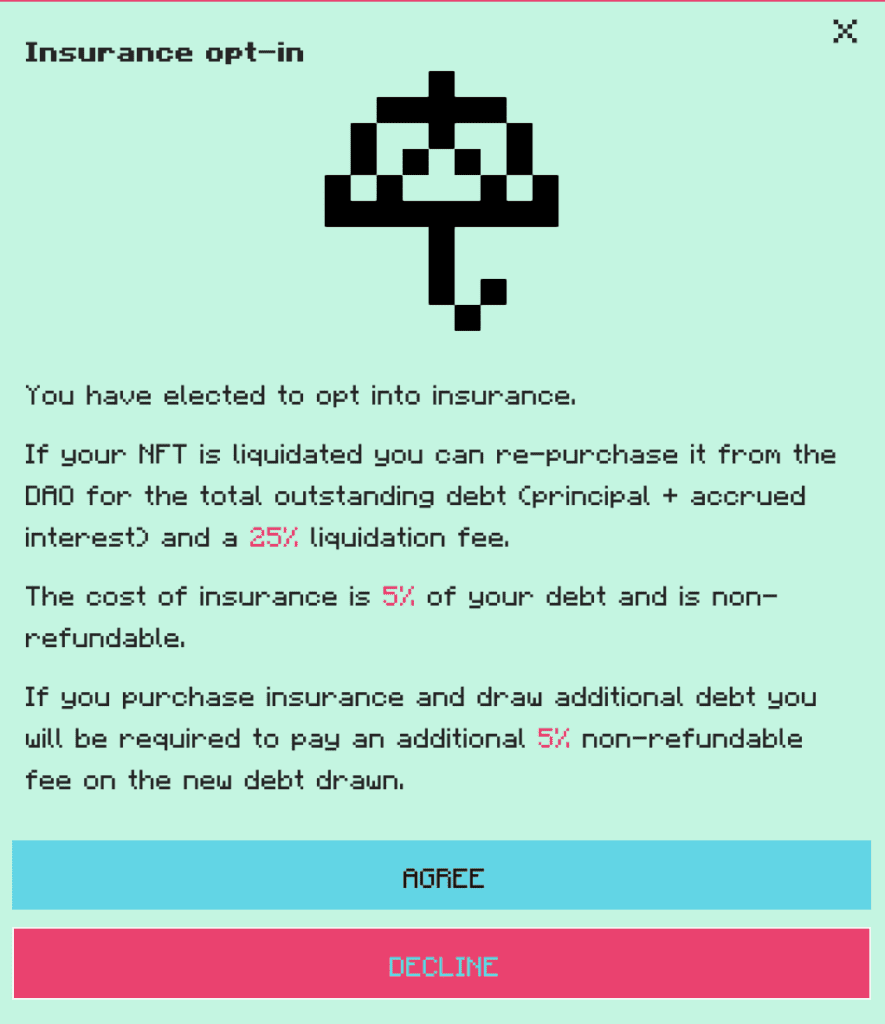
JPEG’d offers a unique DeFi insurance module that users can buy on any CDPs they open. The insurance fee is 5% of the initial debt and any new debt and is non-refundable. Users can reclaim their NFTs after repaying their debt and a 25% liquidation fee. If funds are not transferred to the DAO within 48 hours of liquidation, insurance coverage lapses, and the DAO takes ownership of the NFT.
Liquidations
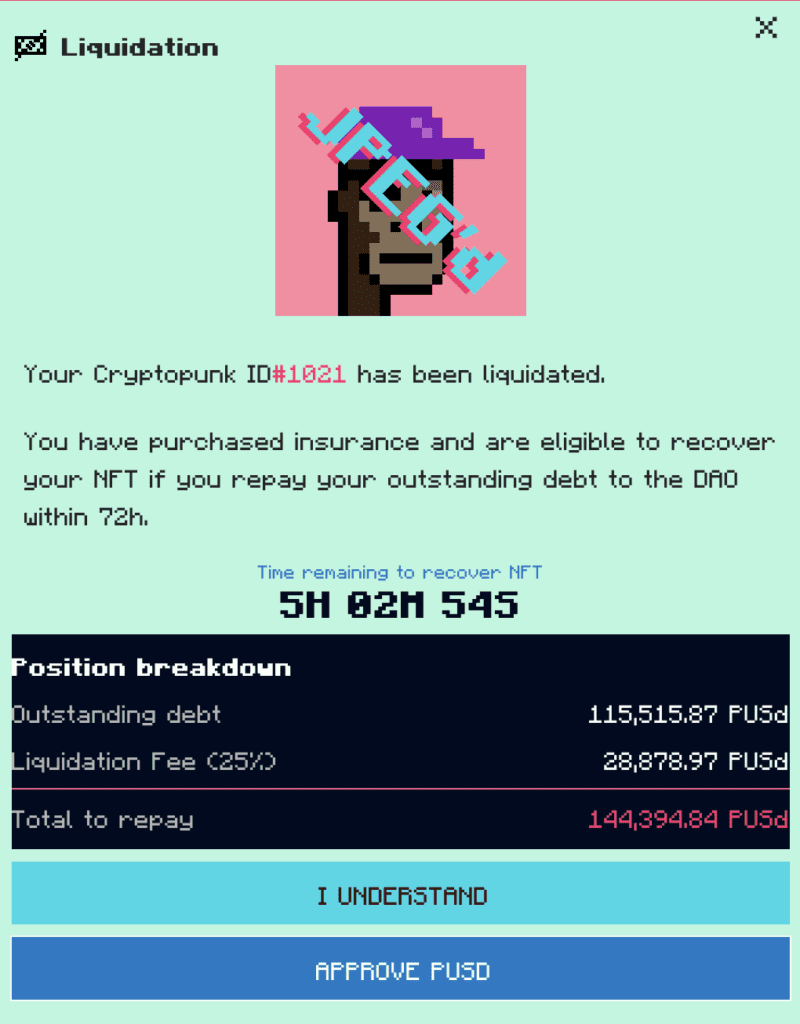
The exclusive ability of the DAO to conduct liquidations enables the unique insurance module. Liquidations happen when debt/collateral value reaches or exceeds the maximum LTV. The DAO settles users’ PUSd debts by burning PUSd during liquidations. Typically, liquidated NFTs are auctioned, and the Auction section of the documentation provides further information.
Locking Mechanics

JPEG’d is a platform that uses locking mechanisms to unlock extra features. These include a Traits Boost that increases credit limit for rarer traits, an LTV Boost that increases LTV up to 25%, and a Cigarette Boost that increases credit limit by 10% on all positions. All locks can be combined, leading to a maximum LTV of 70%, a liquidation ratio of 61%, and a higher credit limit for rarer NFTs for supported collections.
JPEG’d Tokenomics
JPEG, PUSd, and pETH are three tokens associated with the JPEG’d protocol.
JPEG
JPEG is the protocol’s governance token, which allows holders to vote on proposals, access JPEG’d auctions, and increase the LTV on rarer NFTs, although this last feature is currently only valid for Cryptopunks. JPEG can be acquired on SushiSwap or via the dApp’s integrated swap at https://jpegd.io/swap.
PUSd
PUSd is the native stablecoin of the JPEG’d protocol, which is minted when a user borrows against their NFT and burned when they decide to repay their loan. A user cannot borrow both pETH and PUSd from the same vault. PUSd will be situated in a factory pool with a 3Crv pairing, which is a combination of USDC, USDT, and DAI.
pETH
pETH is an Ethereum derivative supported by the JPEG’d protocol, which is minted when a user borrows against their NFT and burned when they decide to repay their loan. Unlike the 2% interest rate for borrowing PUSd, minting $pETH against an NFT has a 5% interest rate. A user cannot borrow both pETH and PUSd from the same vault. pETH will be situated in a factory pool with ETH.

JPEG, the decentralized autonomous organization behind the popular JPEG NFT platform, has a total supply of 69,420,000,000 tokens. Of this total, 30% was generated during the donation event, while 35% was allocated to the DAO. Another 30% is reserved for current and future team members, and the remaining 5% is set aside for advisors. The team and advisor tokens are vested for 2 years linear and have a 6-month cliff beginning on the conclusion of the donation event, which took place on March 1st, 2022. It’s important to note that these tokens are locked and not circulating.
How does JPEG’d work?
Auction
JPEG’d auctions are a type of Open Ascending auction where buyers bid on an item until no one else is willing to bid a higher price. The buyer who places the highest bid becomes the winner of the auction. These auctions last for 24 hours; the winner can ultimately claim their NFT. If a new bid is made less than 5 minutes before the auction ends, the auction is extended by 10 minutes.
This process repeats until there are no more bidders. If you are outbid, you can place another bid with the total amount you are willing to bid. The resulting transaction will be only for the amount needed to match your previous bid. You can withdraw your bid at any time if you have been outbid. Once the auction ends and if you are the winner, you can claim your NFT straight from the auction page.
Eligibility
If you’re interested in participating in an auction, there are three options for locking assets: 5M JPEG, a JPEG card, or a cigarette in the lending contract. The assets will be locked for 7 days, after which the user is free to either keep the assets locked for future bidding or withdraw them for personal use. It’s important to note that locking is a requirement for bidding and that assets will be unavailable during the locking period.
Bidding
When participating in an NFT auction, users who have locked in a 5M JPEG or JPEG Card are able to bid on the auction page using ETH. Bidding is done incrementally and must be at least 1% above the current highest bid. The bidder with the highest bid is not able to withdraw their bid, but all other participants may withdraw their bid at any time. There is no need to withdraw a previous bid in order to place a new one. If a user is outbid, they can place another bid for the total amount they are willing to bid. The transaction for the new bid will only be for the amount needed to match the new bid price.
Roadmap
- Launch formally and add support for CryptoPunks, EtherRocks, and Bored Ape Yacht Club NFTs.
- Add liquidation-free vaults for users to deposit into.
- Explore additional mechanisms that give the JPEG governance token more utility.
- Add other NFT collections to the protocol.
- Onboard permission liquidators will be other DAOs, market makers, significant funds, and even large individual whales.
- Explore options to build a decentralized futures perpetual exchange on essential NFT collections.
Conclusion – JPEG’d Review
In conclusion, JPEG’d is a decentralized lending protocol that aims to bridge the gap between DeFi and NFTs by allowing any NFT collection to obtain a line of credit using their NFTs as collateral. Users can borrow either PUSd or pETH against their supported NFT deposited in a JPEG’d vault.
The protocol is governed by a token, $JPEG, which is responsible for overseeing, administering, and changing the parameters of the protocol. With the JPEG cards, users can stake 1% of the JPEG supply over a month. JPEG’d also offer a unique DeFi insurance module that users can buy on any CDPs they open. The JPEG’d protocol is completely permissionless, decentralized, and not controlled by any central entity, making it a promising platform in the world of NFTs and DeFi.
DISCLAIMER: The Information on this website is provided as general market commentary and does not constitute investment advice. We encourage you to do your own research before investing.
















